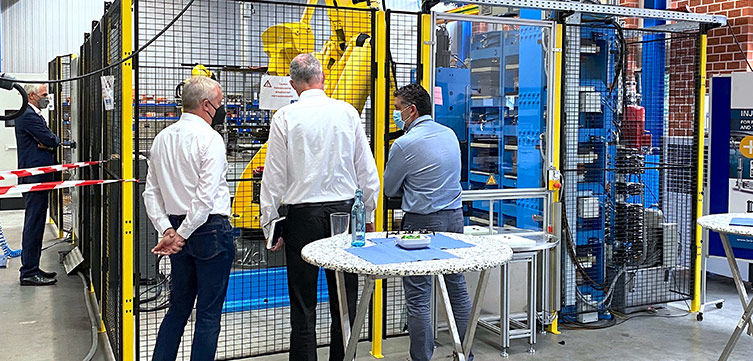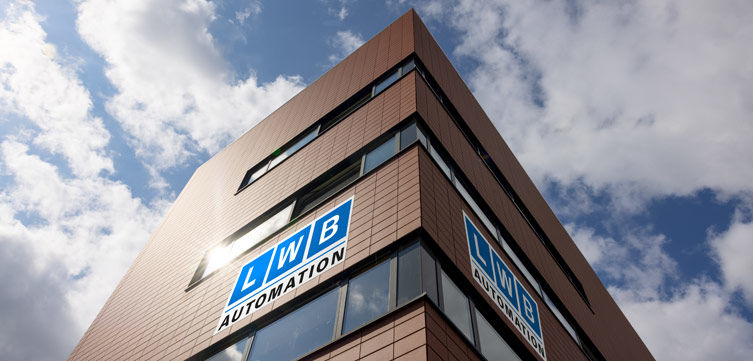From August 16 to 24, 2021, an in-house-exhibition took place at LWB-Automation in Weinheim / Baden-Württemberg, which was aimed at pre-invited company teams and was very well received. One of the reasons for this was the "anti-corona security concept" with pre-booked "time-slots", which limited the number of visitors present at the same time. The side effect of these measures, which was perceived as positive by both sides, was that it made it possible to provide interested parties with individual and more in-depth support.
The central exhibit at the in-house exhibition was the multi-station production cell developed by the Bavarian "LWB-Machinery" in close cooperation with the affiliated "LWB-Automation" in Weinheim. Its concept opens up additional efficiency potential both for the rubber injection molding and the production of thick-walled molded parts made of thermoplastics or silicone.
The second innovation presented was the "universal cell", a new development that sets new standards of flexibility for assembling or manufacturing jobs.

On a total of four event days, the automation exhibits were discussed with numerous company teams in compliance with strict anti-corona measures.
The basic idea is to use the injection molding machine exclusively for what it was designed for: The plasticizing and injection of rubber but also thermoplastics, not however for the unproductive waiting of the vulcanization or cooling time with the closed mold in the machine. As an alternative to this, a system has been developed that allows the vulcanization time to be outsourced from the machine, thus unlocking capacity for additional injection cycles. It consists of an injection molding machine, a 6-axis robot and external heating stations, as well as subsequent stations for demolding and finishing.
This system opens up the possibility of not having to switch after the prototype phase to a multi-cavity mold with the matching "large" machine for a production project, but rather to start with a small machine and a small mold designed with exchangeable mold plates.
After injection, these are taken over by a robot, locked and transferred to an external heating station for vulcanization or cooling, depending on the material being processed. Since that releases free capacity in the injection molding machine, it can be used by inserting additional sets of exchangeable plates.
Their number can grow in line upon demand until a balance is achieved between plasticizing and injection time and the external process times (Curing or colling)
Heating/pressing modules for holding cavity plate sets which, after cavity filling in the injection molding machine (on the left side of above photo), are transferred there by a robot and then passed on to a demolding station.
The multi-station production cell can not only "grow" in line with demand, but can also "shrink" in the event of underutilization, i. e. individual (cost-effective) mold sets can be "decommissioned" or replaced by mold sets for different molded parts.The system concept is modular throughout. This means that the production cell can be "upgraded" to a multi-component production cell by integrating additional machines, robots, heating or cooling stations and demolding stations.During the in-house exhibition, the production of a mounting bearing for an automotive component was demonstrated, consisting of a metal bushing over-molded with a thick-walled spring body made of rubber. The production cell used for this purpose featured a vertical 1000 kN C-frame-machine, a 6-axis robot, 12 heating stations and 10 cavity sets.
The second exhibit was aimed at all users who are doing with assembly and machining tasks in their production.
For this purpose, LWB-Automation presented the universal cell as an exhibition premiere. It consists of a central module (master cell), which integrates a 6-axis industrial robot as standard. On three sides different add-on modules for specific work tasks can be flexibly docked onto the central module.
The processing modules all have running wheels and are docked to the central module via quick-release fasteners and electrical interface plugs. This allows a system changeover in 10 minutes, especially since all modules are pre-programmed and do not require specific knowledge from the operator. The fourth side is provided as a workstation for manual operations.
Since the sequence of the add-on modules can be freely combined, the system is particularly suitable for productions with a high number of variants and/or different quantities
Dominic Bauer, the sales manager for automation systems, summarizes the discussions with the visitors of the in-house exhibition: "The approaches and solutions we developed during the Corona crisis went beyond what we had previously offered to our customers. In the discussions during our in-house-exhibition we have sensed that they were positively received, especially since they open up potential for an increasing efficiency and thus are contributing to a more sustainable way of production."

LWB-Automation in Weinheim / Baden-Württemberg was founded in 2017 and has since been part of the Steinl-group of companies with its headquarters in Altdorf near Landshut / BavariaL
LWB-Automation is a specialist for the development and construction of automation solutions and the construction of special machines; both as single and complex compound systems.
More on website: www.lwb-automation.de
Technical Details
Dominic Bauer – Sales Manager
E-mail: dominic.bauer@lwb-automation.de
Press Contact
Christina Lebeus – Marketing
E-Mail: christina.maniera@lwb.de.com
Author:
Reinhard Bauer – TECHNOKOMM
E-Mail: office@technokomm.at